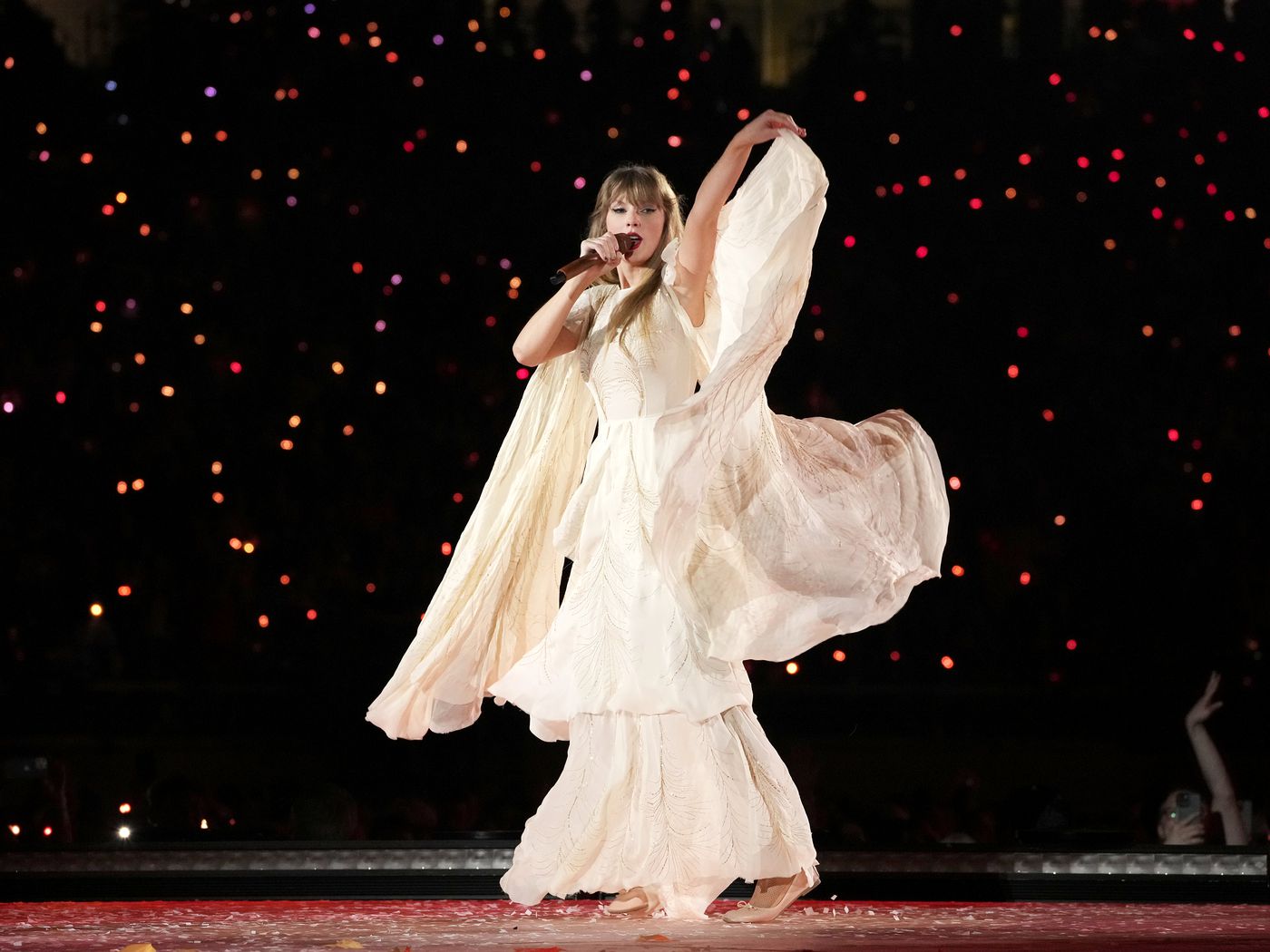Ever wondered about the dazzling performers supporting global music icons? You see them on stage, moving with incredible precision and passion, making those epic concert moments truly unforgettable. It's only natural to wonder about their lives behind the scenes, and a big question that comes up for many fans is how much do Eras Tour dancers make. It's a topic that sparks a lot of curiosity, especially given the sheer scale of such a massive production, so.
Getting a spot on a tour like Taylor Swift's Eras Tour is a huge achievement for any professional dancer, truly. These artists spend years honing their craft, pushing their bodies, and mastering complex routines. Their work is incredibly demanding, blending athletic skill with artistic expression, and it takes a whole lot of dedication. We often see the glamour, but the hard work behind it is immense, you know?
This article will pull back the curtain a bit on what it means to be a dancer on one of the biggest tours ever. We'll explore the factors that shape their earnings, what their daily lives involve, and generally, how the financial side of such a high-profile dance career might look. It’s a fascinating look into a demanding yet rewarding profession, that.
Table of Contents
- Understanding "Much" in Dancer Earnings
- The Life of an Eras Tour Dancer: More Than Just the Stage
- Factors Influencing Dancer Compensation
- What Do Other Professional Dancers Earn?
- The Value Beyond the Paycheck
- Common Questions About Dancer Pay
- Final Thoughts on a Demanding Career
Understanding "Much" in Dancer Earnings
When we ask how much do Eras Tour dancers make, we're really asking about a "large quantity" or a "great amount" of money, in a way. The word "much" itself, as we know, means something substantial in quantity, amount, or degree. So, what does a "substantial" income look like for someone performing on a global stage? For these dancers, it's about whether their earnings reflect the immense talent, dedication, and physical toll their profession demands, you know? It's a question of whether the compensation truly feels like a "large degree" of reward for their unique contribution.
Comparing what they earn to what others in the entertainment world receive can be interesting, too. A professional dancer's income, even on a major tour, might seem like a significant sum to some, while for others, considering the hours and the physical strain, it might not feel like a "far larger amount" than what they truly need or want for their efforts. It’s a subjective measure, very. What one person considers "much" can be quite different from another's perspective, especially when looking at the overall picture of a demanding career, that.
We use "much" with uncountable nouns, typically, like money or effort, and in this discussion, we're certainly talking about a lot of both. The goal here is to shed some light on what that "large quantity" of earnings might be for these incredible performers. It's not just a simple number; it's about the value placed on their unique artistry and athleticism, in some respects. So, let's explore what makes up that "much" in their paychecks, basically.
The Life of an Eras Tour Dancer: More Than Just the Stage
Being a dancer on a tour of this magnitude involves a life that goes well beyond the bright lights of the stage. It's a demanding schedule, requiring constant readiness and a deep commitment to the art form. The physical and mental stamina needed are truly immense, honestly. These performers live and breathe their craft every single day, you know?
Auditioning for the Dream
The path to becoming an Eras Tour dancer begins with an incredibly competitive audition process. Thousands of talented dancers from around the world might try out for just a handful of spots. It requires not only exceptional dance skill but also a unique stage presence and the ability to adapt to different styles, like. Dancers must show versatility, precision, and an energy that matches the artist's vision. It's a rigorous selection that picks the very best, you know?
Hopefuls often spend weeks, or even months, preparing for these high-stakes auditions. They practice specific choreography, work on their freestyle, and refine their individual performance qualities. The pressure is immense, as securing a spot on such a tour can be a career-defining moment, a matter of fact. It’s a very challenging time for many, as the competition is fierce, so.
Rigorous Rehearsals and Training
Once selected, the real work begins with intensive rehearsals. These are not just a few hours a day; they often stretch for long, demanding days, sometimes weeks, leading up to the tour launch. Dancers learn intricate choreography, stage blocking, and how to interact with props and other performers, typically. They must memorize complex routines for every song, ensuring they are perfectly synchronized and convey the right emotion.
The physical demands are extreme, requiring peak physical condition. Dancers train for endurance, strength, and flexibility, often working with trainers and physical therapists to prevent injuries. They repeat routines over and over, perfecting every movement until it becomes second nature, pretty much. This period is vital for building the show's foundation, and it’s a very tiring but rewarding time, you know?
Beyond the physical, there's a huge mental component to these rehearsals. Dancers must stay focused, absorb feedback quickly, and maintain a positive attitude through long hours. They become a cohesive unit, a team that relies on each other for the success of every performance, in a way. This collective effort is what makes the show flow so seamlessly, like your favorite song, you know?
Life on the Road
Touring life is a constant cycle of travel, performance, and recovery. Dancers spend much of their time moving from city to city, living out of suitcases, and adapting to new environments daily. They perform multiple shows a week, each requiring the same high level of energy and precision as the last, basically. It’s a whirlwind of airports, hotels, and arenas, you know?
Despite the excitement of performing for huge crowds, the routine can be physically draining. They need to manage their sleep, nutrition, and physical therapy to stay healthy and perform at their best. Downtime is often spent resting or exploring new cities briefly, but the focus remains on the next show, very. It's a unique lifestyle that requires a lot of discipline and resilience, that.
The bond among the dancers becomes incredibly strong, as they share this intense experience together. They become a sort of family on the road, supporting each other through the highs and lows of touring. This camaraderie is a huge part of what makes the demanding schedule manageable, actually. It's a special kind of connection, you know?
Factors Influencing Dancer Compensation
When it comes to how much do Eras Tour dancers make, several elements come into play, influencing their overall earnings. It's not just a flat rate for everyone; their pay is a combination of different components that reflect the scale of the tour and their individual contributions, you know? Understanding these factors helps paint a clearer picture of their financial situation, so.
Base Salary and Per Diems
The primary component of a touring dancer's income is their base salary. This is typically a weekly or bi-weekly payment negotiated before the tour begins. For a major artist like Taylor Swift, these salaries are generally quite good, reflecting the high demand for top-tier talent and the extensive commitment required. Industry sources suggest that dancers on such large tours can earn anywhere from a few thousand dollars per week, sometimes more, depending on various factors, pretty much.
In addition to their salary, dancers also receive a "per diem," which is a daily allowance for living expenses like food and incidental costs while they are on the road. This money helps cover their day-to-day needs, meaning they don't have to spend their salary on basic necessities while away from home, in a way. It's a crucial part of their compensation package, ensuring they can maintain a good quality of life while traveling, you know?
The per diem amount can vary, but it's designed to cover reasonable expenses in different cities. This means a dancer can focus on their performance without worrying too much about where their next meal is coming from or how they will manage small daily costs, basically. It adds a layer of financial security to their demanding schedule, that.
Benefits and Royalties
Beyond the direct pay, dancers on major tours often receive benefits. These can include health insurance, which is incredibly important given the physical nature of their work. Some tours might also offer retirement contributions or other perks, though these can vary widely depending on the artist and the management company, you know? These benefits add significant value to their overall compensation, as a matter of fact.
For some high-profile tours, dancers might also receive royalties, especially if their performances are featured prominently in concert films, documentaries, or live album recordings. This is less common for every dancer, but for those with significant contributions or unique roles, it can be a nice bonus. These residual payments can provide income long after the tour concludes, offering a bit of long-term financial stability, you know?
The specific terms for benefits and royalties are usually outlined in their contracts. These agreements are often complex, detailing every aspect of their employment, from pay schedules to travel arrangements and intellectual property rights. It's a very detailed setup, ensuring everything is clear for both sides, so.
Experience and Role
A dancer's experience level plays a significant part in their earning potential. Dancers with years of professional touring experience, a strong reputation, and specialized skills often command higher salaries. Their proven track record of reliability and excellence is highly valued, you know? Newer dancers, while incredibly talented, might start at a slightly lower rate, gaining experience as they go, pretty much.
The specific role a dancer plays in the show also influences their pay. Lead dancers, dance captains, or those with unique solo parts typically earn more than ensemble members. A dance captain, for example, has added responsibilities, like helping to teach choreography, maintaining consistency, and sometimes even leading rehearsals. This extra work comes with extra pay, naturally. It’s a recognition of their leadership and added duties, that.
Sometimes, dancers who also contribute to choreography or creative direction might see their pay increase further. Their creative input adds another layer of value to the production, making them even more integral to the show's success. It’s a way of recognizing all the different talents they bring to the stage, you know?
Tour Duration and Scale
The overall length and scale of the tour are huge factors in a dancer's total earnings. A multi-year, global tour like the Eras Tour offers a steady, extended period of employment, meaning a much larger total income over time compared to a shorter, regional tour. The longer the tour runs, the more weeks of pay a dancer accumulates, very. This extended employment offers a significant financial benefit, you know?
The size of the production also matters. Mega-tours have larger budgets, which generally allows for better compensation for all crew members, including dancers. These tours involve massive sets, intricate costumes, and a huge team, all of which reflect a significant financial investment. This larger scale often translates into better pay for the performers, as a matter of fact.
Conversely, smaller tours or one-off performances might pay less per week or per show, but they might also offer different kinds of opportunities. The Eras Tour, however, stands out for its sheer size and duration, making it a highly sought-after gig for professional dancers looking for substantial, consistent work, in some respects. It's a rare opportunity, that.
What Do Other Professional Dancers Earn?
To put the Eras Tour dancer earnings into perspective, it helps to look at what other professional dancers make in different parts of the industry. The dance world is incredibly diverse, with varying pay scales depending on the field, the level of expertise, and the type of work. This comparison helps us understand if the Eras Tour pay is indeed "much" by industry standards, you know?
For instance, dancers in Broadway shows often earn a weekly salary based on union agreements (like Actors' Equity Association). These salaries can range from around $1,500 to $2,500 per week for ensemble members, with principal dancers or dance captains earning more. This includes benefits and sometimes additional pay for swings or understudies. It's a stable, though demanding, form of employment, very. This kind of work is typically consistent for the run of a show, that.
Dancers working in commercial gigs, like music videos, commercials, or award shows, often get paid per project or per day. These rates can vary wildly, from a few hundred dollars for a small gig to several thousand for a high-profile commercial. However, these jobs are often sporadic, meaning dancers must constantly audition and hustle to string together consistent work, you know? The income can be unpredictable, pretty much.
Ballet and contemporary dance company members typically earn a set salary, which can range from $400 to over $1,500 per week, depending on the company's size, prestige, and location. These positions often come with benefits and a steady schedule of rehearsals and performances. While the artistic fulfillment is immense, the pay might not always match the physical demands, in a way. It's a different kind of dedication, so.
Comparing these figures, it becomes clear that being a dancer on a mega-tour like the Eras Tour places performers at the higher end of the earning spectrum for the dance profession. The consistent work, the scale of the production, and the global reach all contribute to a compensation package that is, by many measures, quite significant for a dancer, actually. It’s a truly sought-after position, you know?
Learn more about on our site for more insights into the entertainment industry.
The Value Beyond the Paycheck
While the financial compensation is certainly a major factor, the value of being an Eras Tour dancer extends far beyond the paycheck. For many, the experience itself is priceless, offering unparalleled opportunities for growth, exposure, and artistic fulfillment. This kind of tour provides a unique platform for a dancer to showcase their talent to millions, you know?
The exposure gained from performing on such a massive global stage is immense. Dancers become visible to countless fans, industry professionals, and potential future employers. This can open doors to other high-profile projects, collaborations, and even personal branding opportunities. It’s a huge boost for their careers, providing a very wide reach, you know?
Working alongside a superstar artist and a world-class creative team offers incredible learning experiences. Dancers learn new techniques, refine their performance skills, and gain insights into the workings of a large-scale production. The mentorship and professional development they receive are invaluable, shaping them into even more accomplished artists, in some respects. It's like a masterclass every day, that.
The camaraderie and connections formed with fellow dancers, musicians, and crew members are also a huge part of the experience. These relationships can last a lifetime, providing a network of support and collaboration within the industry. It's a unique bond forged through shared hard work and unforgettable moments, basically. This community aspect is incredibly rewarding, you know?
Ultimately, for many dancers, the artistic fulfillment of performing live for massive audiences is a powerful motivator. The energy from the crowd, the precision of the performance, and the joy of bringing a show to life are deeply satisfying. This passion for their art often outweighs purely financial considerations, making the demanding lifestyle worthwhile, very. It's a dream come true for many, that.
Common Questions About Dancer Pay
Do Eras Tour dancers get paid well?
Yes, compared to many other dance jobs, Eras Tour dancers likely receive very good compensation. This includes a competitive base salary, per diems for living expenses, and potentially benefits like health insurance. The scale and duration of the tour contribute to a substantial overall income for these performers, you know? It's considered a top-tier gig in the dance world, honestly.
How much do backup dancers make per show?
Backup dancers on a major tour are typically paid a weekly salary rather than a per-show rate. This weekly pay covers all rehearsals, performances, and travel days within that week. While a specific per-show breakdown isn't usually how it works, their weekly earnings reflect the intensity of their schedule, which often includes multiple shows, pretty much. It's a consistent pay structure, that.
What are the benefits of being an Eras Tour dancer?
Beyond the financial compensation, benefits for Eras Tour dancers include significant career exposure to a global audience, invaluable professional development from working with top industry talent, and the formation of strong personal and professional relationships with fellow performers and crew. The artistic fulfillment of performing on such a grand scale is also a huge benefit, you know? It's a comprehensive package of rewards, in a way.
Final Thoughts on a Demanding Career
The question of how much do Eras Tour dancers make reveals a lot about the dedication and skill required for such a high-profile career. These artists commit their lives to their craft, enduring rigorous training and a demanding touring schedule. Their compensation reflects the immense value they bring to a show that captivates millions worldwide, you know?
It's a profession where the financial rewards, while significant for a tour of this magnitude, are often intertwined with the passion for performance and the unique experiences gained. The life of a touring dancer is challenging, but for those who achieve it, it's also incredibly rewarding, very. It’s a testament to their talent and hard work, that.



